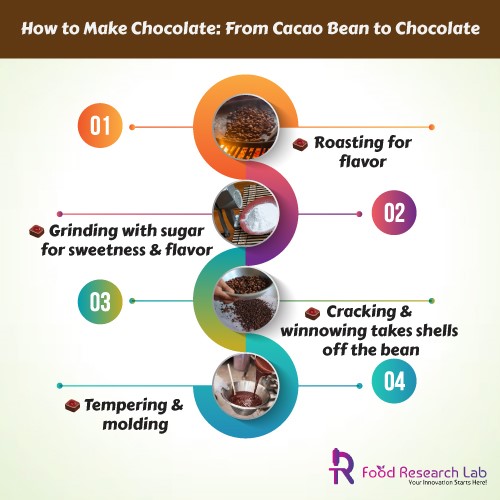
How to make Chocolate: from Cacao Bean to Chocolate
1. Cleaning
The method of manufacturing chocolate begins with passing cocoa beans through a machine that eliminates dried cocoa pulp, bits of the pod, and other foreign matter. The beans are weighed and mixed according to the manufacturer’s instructions.
2. Roasting
The beans are roasted in substantial rotating cylinders to bring out the distinctive chocolate fragrance. Depending on the bean type and desired final result, roasting takes 30 minutes to two hours at 250 degrees Fahrenheit or more. The beans’ moisture level decreases as they are turned over and over, their colour changes to a rich brown, and the distinctive scent of chocolate emerges.
3. Shell removal
The cocoa beans are immediately chilled, and their thin shells are removed, which have grown brittle due to roasting. A massive winnowing machine that cracks rather than crushes the beans by passing them between serrated cones. A succession of mechanical sieves separates the shattered pieces into big and tiny grains, while fans blast away the thin, light shell from the flesh, called “nibs,” during the process.
4. Grinding
The nibs contain around 53% cocoa butter, are then milled and crushed into a cocoa paste between huge grinding stones or heavy steel discs. After applying hydraulic pressure to the paste, the cocoa butter that emerges is pure and precious fat with a distinct scent; after filtering and purifying, it resembles regular butter.
5. Separation
To produce cocoa powder, follow these steps. When chocolate liquid is pushed into hydraulic presses weighing up to 25 tonnes, 80 per cent of the cocoa butter is extracted. The fat drains as a yellow liquid through metallic screens and is collected for use in chocolate production. Unique among vegetable fats, cocoa butter, is a solid at room temperature and melts at 89 to 93 degrees Fahrenheit, Slightly below body temperature. Cocoa butter may be stored for years without deteriorating if stored properly.
6. Final process
Heat, Cool, and Reheat is used to temper chocolate. This thickens the chocolate while also providing the necessary flow characteristics for filling the moulds. This complex process is carried out at the tempering plant and is required to give the final chocolate product a delicate composition, a consistent structure, and a well-rounded flavour. In this approach, the storage life is also extended.






